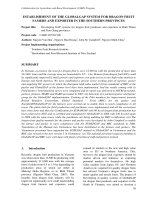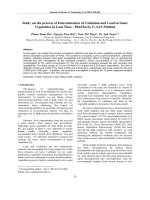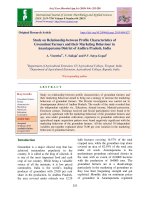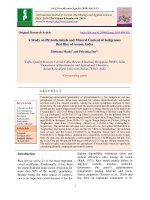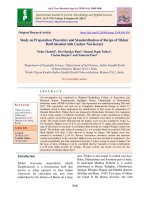Study on morphology, biology of Thrips palmi and efficiency of different concentration of neem leaf extract on dragon fruit
Bạn đang xem bản rút gọn của tài liệu. Xem và tải ngay bản đầy đủ của tài liệu tại đây (176.23 KB, 6 trang )
Vietnam Academy of Agricultural Sciences (VAAS)
STUDY ON MORPHOLOGY, BIOLOGY OF rips palmi AND EFFICIENCY OF
DIFFERENT CONCENTRATION OF NEEM LEAF EXTRACT ON DRAGON FRUIT
Tran i My Hanh *1, Nguyen i Cam Giang1,
Nguyen Van Hoa1, Rangaswamy Muniappan2
Abstract
A study on morphology and biology of rips palmi and e ect of some insecticides and neem leaf extract on dragon
fruit was conducted at Southern Horticultural Research Institute (SOFRI) and the dragon fruit farms at Duong
Xuan Hoi village, Chau anh district, Long An province from April 2016 to December 2017. e results showed
that the adult of rips palmi was light yellow, antennae of male had seven segments and eggs were milky white in
color. e life cycle of rips palmi completed in 14 - 22 days. e lab trial to study e ciency of nine concentrations
of neem leaf extract was conducted at Plant Protection Division-SOFRI; the results showed that two treatments of
neem leaf extract were highly e ective against rips palmi with a concentration of 8% (80.83%) and 9% (84.64%) at
7 days a er spraying in lab conditions. e results on eld trial indicated that neem leaf extract at 8% concentration
was 77.91% e cient, which was as e ective as Spinetoram, Imidacloprid, and Azadirachtin + Emamectin to control
rips palmi at eld condition. e rate of “ring net” phenomenon of four treatments: Spinetoram, Imidacloprid,
Azadirachtin + Emamectin, and Azadirachta indica-neem leaf extract (12.75 - 17.43%) were low and signi cantly
di erent compared with the control (42.12%).
Keywords: Dragon fruit, neem leaf extract, “ring net” phenomenon, so insecticides, rips palmi
INTRODUCTION
Currently, the area of dragon fruit in Vietnam is
estimated for 45,449 hectares and is commonly grown
in Binh uan, Long An and Tien Giang provinces
with productivity of 487,968 tons (MARD - Vietnam,
2017). It is considered a fruit that helps Vietnamese
growers escape poverty. About 80% of dragon fruit
production in Vietnam exports to 40 countries and
regions in the world, including the high quality
requirement markets such as USA, Europe, and Japan.
As the demand for dragon fruit is expanding, the
growers are not able to manage dragon fruit orchards
properly, leading to some new emergence of pests and
diseases, causing major damage to production, and
threatening the export of dragon fruit in the future.
Behind canker disease, which seriously damages
dragon fruit production, thrips also contribute
damage on this crop. ey attack owers and young
fruits. At thrips infested sites, the symptoms on fruit
are scab-like, rough skin which is called “ring net”
or “da banh” phenomenon. e owers could dropdown if there is a high population of thrips. rips
do not signi cantly a ect yields, but greatly a ect the
exportation capacity, which reduces the commercial
value of the fruit (Martin and Mau, 1992). Huynh
anh Loc (2016) reported that collecting of dragon
fruit owers with 85 samples in Tien Giang and 35
samples in Long An showed that two species of thrips
were found on dragon fruit owers, namely rips
palmi Karny and Scirtothrips dorsalis Hood.
e
major damage to dragon fruit ower was rips palmi
Karny with 88.24% and 85.71% in Tien Giang and
Long An, respectively. rips have many host plants
and high pesticide resistance capacity, so control of
the pest is very di cult (Hamid-Reza, 2009). Besides
that, insecticide residues in agricultural products,
especially fresh vegetables and fruits, increase the
risk of cancer in consumers and producers (Fitriasari
and Prijono 2009). As a result, it is necessary to
nd a safe and e ective method to control the pest.
Some plants contain many compounds, which have
insecticidal, antifeedant, and growth inhibitor e ect
on this pest. Many compounds have no toxic e ect or
a low toxicity to non-target pests and humans, and are
environmentally-friendly (Wei et al., 2011). Today,
neem products are also used selectively in controlling
pests of various economically useful plants. e seeds
contain a complex secondary metabolite azadirachtin
which acts as an anti-feedant and repellent to protect
the crop from insects.
Although rips palmi is common on other crops,
thrips has just occurred on dragon fruit in the South
of Vietnam. e study on this pest on dragon fruit
has not yet been conducted. e growers at focus
dragon fruit areas do not know the timing of peak
thrips population, or which methods to use to control
them. us, study on morphological and biological
characteristics of Melon thrips and e cacy of some
botanical and so insecticides to control the thrips on
dragon fruit was performed.
Southern Horticultural Research Institute, Box 203, My o city, Tien Giang, Vietnam
IPM Innovation Lab, Virginia Tech, 526 Prices Fork Road, Blacksburg, VA 24061
*
Corresponding author: Tran i My Hanh. Email:
1
2
108
Journal of Vietnam Agricultural Science and Technology - No.1(3)/2018
MATERIALS AND METHODS
Materials
Melon thrips, red esh dragon fruit variety orchard,
dragon fruit owers; Magni er, Olympus uorescence
microscope, Soxhlet distillation, sprayer; So brush,
vial, blotting-paper, plastic bag, petri dish, slide, lame,
scissors, cage netting (180 ˟ 130 ˟ 100 cm); Alcohol
98%, HCl 10%, NaCl, KOH, Chloral hydrate, Gum
Arabic, NaOCl, glycerin, metanol, distilled water,
Hoyer media; So insecticides and neem extract:
Spinetoram (Spinetoram 60EC), Imidacloprid
(Imidacloprid 050SC), Azadirachtin+ Emamectin
(Promathion 55EC), Azadirachta indica-neem leaf
extract, and Allium sativum-commercial garlic
powder product.
Methods
Study on morphology and biology of
dragon fruit
rips palmi on
For biology observation, one male and one female
adult were put into a box (13 ˟ 9 cm) with some ower
petals, adding honey as food for the thrips. Daily
observation of the petals to nd new eggs took place
every 12 hours. A small needle was used to separate the
petal containing the eggs and each egg was placed into
a small petri dish with the new petal base on absorbent
paper. e petals were replaced when needed. Each
stage of the thrips was observed at least 30 individuals
every 8 hours and speci c time of change stages of the
thrips, following method of Ha Quang Hung (2005)
with modi cations. Duration of developmental stages
of eggs, larvae, pre-pupae, pupae and the time of the
rst egg occurrence, and life cycle of the thrips were
recorded. e thrips were reared at room conditions
at 28 ± 1oC and 65 ± 5% RH.
For morphological observation, the larvae, pupae,
and adults were xed in Hoyer media following the
methods of Krantz (1975).
ese specimens were
observed using a 40-100X magni er, following
taxonomic system of Mound and Azidah (2009) and
Chin (2016).
E ciency of some so insecticides and plant extracts
against rips palmi on dragon fruit
Preparing neem leaf extract: Neem leaves were
extracted using a Soxhlet distillation (Behr Labor
Technik-R 106S), according to Dodia et al. (2008).
Laboratory trial: Dragon fruit ower petal of 20 cm
diameter was cut, dipped in various concentrations of
neem leaf extract, and kept above moistened cotton
in petri dish. Twenty individuals of larvae
rips
palmi were released onto the ower petal. All petri
dishes were kept at 28 ± 1oC and 65 ± 5% RH in lab
conditions. e trial was arranged in a randomized
complete design consisting of ten treatments (nine
treatments at nine concentrations of neem leaf extract
at 1%, 2%, 3%, 4%, 5%, 6%, 7%, 8%, 9%, and control
treatment which was sprayed with water, respectively)
with three replications for each treatment with a petri
dish per replication. Number of living individuals in
each treatment a er 1, 3, 5, and 7 days a er spray were
recorded. e e ciency (H%) of neem leaf extract at
di erent concentrations was calculated according to
Abbott formula.
Field trial:
e experiment was performed at the
dragon fruit orchard at Duong Xuan Hoi village,
Chau anh, Long An to evaluate the e cacy of some
so insecticides and neem leaf extract and which
concentration showed high e ectiveness to control the
thrips in lab conditions. e treatment was arranged
in a randomized complete blocks design consisting
of six treatments (T1-Spinetoram (15 mL/16L),
T2-Imidacloprid (10 mL/16L), T3-Azadirachtin +
Emamectin (50 mL/16L); T4-Azadirachta indicaneem leaf extract (8%), T5-Allium sativum (1%),
and T6-control-water) with eight replications per
treatment with a dragon fruit tree containing more
than 20 ower buds 10 days of age per replication.
So insecticides and neem leaf extract were applied
by a motor sprayer. e volume of applied mixture
was 100 liters per ha. e number of living individuals
was recorded before spray, 3, 7, and 10 days a er
spray. Besides that, the rate of “ring net” phenomenon
on the fruits was recorded at harvest time, following
formula: Percentage of infected fruit (%) = (Total
infected fruits/Total observed fruits) ˟ 100.
e
e ciency of the so insecticides and neem leaf extract
was estimated by Henderson Tilton formula (1955).
Data analysis
e morphology and biology data was carried out
using Microso Excel so ware. e data of the trials
in lab and eld conditions was analyzed using the
analysis of variance (ANOVA) and the mean values
were compared by using the Duncan using statistical
package for the social sciences (SPSS) 16.0 version.
Time and place of the study
Time: From April 2016 to December 2017.
Place: A study on morphology and biology of rips
palmi and e ect of some insecticides and neem leaf
extract on dragon fruit was conducted at Southern
Horticultural Research Institute (SOFRI) and the
dragon fruit farms at Duong Xuan Hoi village, Chau
anh district, Long An province.
109
Vietnam Academy of Agricultural Sciences (VAAS)
RESULTS AND DISCUSSION
Morphology and biology of Melon thrips (
palmi) on dragon fruit
rips
Morphological characteristics:
e eggs were
deposited individually in the host tissue underneath
the epidermal layer slightly overhanging. e eggs
were o en laid on ower or young fruit especially
near tail of fruit. e eggs were white in color then
later turned to milky white, 0.16 - 0.20 mm in length,
and kidney shaped. e rst instar larvae were milky
white then turned yellowish, 0.34 ± 0.03 mm in length,
0.15 ± 0.01 mm in width, did not divide thorax and
abdomen, and had red compound eyes. e second
of larval stage was yellow in color, 0.62 ± 0.08 mm in
length, 0.18 ± 0.02 mm in width. e immature stages
were wingless. e pupal stage was divided into two
periods: pre-pupa and pupa. e pre-pupa stage was
0.77 ± 0.11 mm in length, 0.23 ± 0.04 mm in width,
had wing up to the third abdomen segment, antenna
forward. e pupa was 0.88 ± 0.10 mm in length, 0.27
± 0.03 mm in width, had a long wing up to the fourth
abdomen segment, and antennae tilted rearwards to
get close to the body. e adult was small, light yellow
in color, 0.98 ± 0.20 mm in length, 0.29 ± 0.06 mm
in width, antenna had seven segments with the 3rd
and 4th segments of antennae had sensory organs that
were cone-shaped and divided into two branches.
e wings were long, transparent, with fringe of setae
around the outside edge of wings.
Biological characteristics: A female laid an average of
42 ± 4.78 eggs when mating a male and a female. e
eggs lasted 3 - 5 days. e rst instar larvae were active
and its last 2 - 3 days duration. e second instar took
3 - 4 days, average of 3.47 ± 0.51 days. Its sucking
capacity was better than the rst instar, and it moved
slower when moulting into the pupal stage. e prepupal stage was 2 - 3 days, while the duration of pupa
lasted 2 - 4 days. e life cycle of the thrips on dragon
fruit was an average of 17.41 days at 28 ± 1oC and 65 ±
5% RH (Table 1). e stage of egg to adult was found
on ower or young fruit, but pupal stage was found
on the soil around the stump. e thrips adult moved
quickly on the surface of ower buds, young fruits,
particularly near fruit tails. Fruit damage is caused
by feeding and oviposition. Both larvae and adults
sucked in the resin. Feeding damage was found in
slightly raised areas around fruit tail that were grayish
brown to grayish silver at rst developing brown scab.
e damage area could extend to cover most tails of
infected fruit. e symptom on fruit was scab-like.
110
When the fruit was over 7 days of age the thrips were
not able to damage the fruit. e damage had a ected
economic value of the fruit.
Table 1. Developmental stages
of rips palmi on dragon fruit
Developmental
stages
Egg
First larva instar
Time (days)
Fluctuation Average ± SD
3–5
3.77 ± 0.82
2–3
2.53 ± 0.51
Second larva instar
3–4
3.47 ± 0.51
Pre-pupa
Pupa
2–3
2–4
2.47 ± 0.51
2.80 ± 0.76
Adult
2–3
2.37 ± 0.49
14 – 22
17.41 ± 3.52
Life cycle
Notes: Average: Means of 30 individuals was observed.
In this study, the results of morphology and biology
of
rips palmi on dragon fruit owers at room
temperature of 28 ± 1oC, RH 65 ± 5% showed that
the thrips caused “ring net” phenomenon on dragon
fruit. e life cycle was 14 - 22 days. is result was
similar to some studies on biological characteristics
of rips palmi, the life cycle lasted 17.5 days at 25oC
(Wang et al., 1986); 26 days at 17oC (Martin and
Mau, 1992).
In dragon fruit crop, the eggs of T. palmi hatched
a er 3.77 ± 0.82 days, similar to other results, 3 days
(Martin and Mau, 1992) and 3.79 days (Hoang Anh
Tuan, 2002).
E ciency of some so insecticides and neem leaf
extract against rips palmi on dragon fruit
Laboratory trial: e results of the trial showed that
e ciency of all treatments of di erent concentrations
of neem leaf extract against the thrips were
signi cantly di erent in comparison with control at
1 day a er spray, but among di erent concentration
treatments were not signi cantly di erent. At 3 days
a er spray, the treatment of 8% neem concentration
was highly e ective (43.57%) against T. palmi,
and di ered signi cantly in comparison with the
treatments of 1%, 2% concentration and control. e
treatments of concentrations from 4% to 9% were
highly e ective in controlling T. palmi compared with
concentrations from 1% to 3% and control at 5 days
a er spray. Two treatments were highly e ective, 8%
(80.83%) and 9% (84.64%) concentrations compared
to other treatments in controlling the thrips at 7 days
a er spray at lab conditions (Table 2).
Journal of Vietnam Agricultural Science and Technology - No.1(3)/2018
Table 2.
Treatment
Neem leaf extract 1%
Neem leaf extract 2%
Neem leaf extract 3%
Neem leaf extract 4%
Neem leaf extract 5%
Neem leaf extract 6%
Neem leaf extract 7%
Neem leaf extract 8%
Neem leaf extract 9%
Control
CV (%)
e e ciency of neem leaf extract of
rips palmi at nine concentrations
E ciency (%)
1 DAS
7.12a
10.63a
10.72a
12.38a
15.99a
12.38a
14.13a
14.23a
14.23a
0b
28.21
3 DAS
18.13c
21.74bc
23.78abc
27.39 abc
36.45 abc
32.65 abc
34.21 abc
43.57 a
41.62ab
0d
15.99
5 DAS
29.7b
38.97b
42.58b
57.52a
64.73a
63.10a
64.43a
70.41a
70.20a
0d
7.79
7 DAS
44.34c
44.23c
50.00c
67.32b
73.09ab
78.87ab
76.80ab
80.83a
84.64a
0d
7.07
Notes: DAS: day a er spray. e data was converted to arcsin (x + 0.5)½ before statistical analysis.
within a column marked by the same letter were not signi cantly di erent at 99%.
e current insecticides have mainly caused
resistance in outbreaks of Melon thrips on many
crops, which showed that chemical treatments were
not e ective in controlling thrips (Morse and Hoddle,
2006). e e ect of ethanolic Azadirachta indica and
Allium sativum extracts on T. palmi showed that the
mortality percentage of the thrips (1 - 2 days old) a er
72 h was more than 66% (Najmizadeh et al., 2012).
Field trial:
e results of the trial showed that
e ciency of all treatments against the thrips were
signi cantly di erent in comparison with control at
3 and 7 days a er spray, but were not signi cantly
di erent together against the thrips. At 10 days a er
spray, Spinetoram treatment was highly e ective
(89.14%), next to Imidacloprid (75.72%), Azadirachta
indica-neem leaf extract (77.91%), and Azadirachtin
+ Emamectin (74.57%) di ered signi cantly in
controlling the thrips compared with other treatments.
e treatment of Allium sativum-commercial garlic
powder (52.66%) had lower e ectiveness than other
treatments in controlling the thrips at eld condition
(Table 3).
e result of the eld trial indicated that neem leaf
extract at 8% concentration was 77.91% e cient,
which was as e ective as Spinetoram, Imidacloprid,
and Azadirachtin + Emamectin to control T. palmi at
eld condition. Arutselvi (2012) recorded that neem
leaf extract at 20% concentration was 77.67% e ective
in controlling Panchaetothrips indicus in Curcuma
longa leaves. Boricha (2010) reported that combining
chemical insecticides and bio-insecticides controlled
e value means
rips tabaci attacking cotton. Besides that, Cermeli
(1993) reported that 11 insecticides were tested
to against thrips on soybeans, the results showed
that Flu loxuron, Imidaclopid, Chlo uazuron and
Oxamy were most e ective, but no insecticide was
e ective over 80%.
Table 3. e e ciency of some so insecticides
and neem leaf extract against T. palmi
on dragon fruit in eld condition
Treatment
E ciency (%)
3 DAS
7 DAS
10 DAS
Spinetoram
61.84
76.47
b
89.14a
Imidacloprid
53.32b
65.22b
75.72ab
Azadirachtin+
Emamectin
57.18b
59.40b
74.57ab
Azadirachta indicaneem leaf extract
54.61b
63.12b
77.91ab
Allium sativumcommercial garlic
powder
47.12b
51.24b
52.66b
Control
0a
0a
0c
CV (%)
41.13
39.32
34.97
b
Notes: DAS: day a er spray. e data was converted to
arcsin (x + 0.5)½ before statistical analysis. e value
means within a column marked by the same letter were
not signi cantly di erent at 99%.
e impact of so insecticides and neem leaf extract
against the thrips to rate of “ring net” phenomenon:
e results claimed that the rate of “ring net”
111
Vietnam Academy of Agricultural Sciences (VAAS)
phenomenon infected fruit at harvest time was highest
in the control (42.12%), following the treatments
of Allium sativum-commercial garlic powder with
a rate of 23.14%. In contrast, the rate of “ring net”
phenomenon of four treatments, Spinetoram;
Imidacloprid; Azadirachtin + Emamectin; and
Azadirachta indica-neem leaf extract, were 12.75 17.43% lower signi cantly di erent in comparison
with the control (Table 4).
e data was converted to arcsin (x + 0.5)½ before
statistical analysis. e value means within a column
marked by the same letter were not signi cantly
di erent at 99%.
Figure 1. (A) Adult, (B) Antenna of
Treatment
Spinetoram
Imidacloprid
Azadirachtin+Emamectin
Azadirachta indica-neem
leaf extract
Allium sativum
Control
CV (%)
The rate of “ring net”
phenomenon (%)
12.75b
13.54b
17.43b
16.12b
23.14ab
42.12a
37.32
rips palmi, and (C) Symptom of mature fruit
CONCLUSIONS AND RECOMMENDATIONS
In this study, the results of morphology and biology
of
rips palmi on dragon fruit owers at room
temperature of 28 ± 1oC, RH 65 ± 5% showed that the
eggs were white in color, and then turned to milky
white, 0.16 - 0.20 mm in length, and kidney shaped.
e rst instar larvae were milky white, then turned
yellowish, 0.34 ± 0.03 mm in length. e second of
larval stage was yellow in color, 0.62 ± 0.08 mm in
length. e pupa was 0.88 ± 0.10 mm in length. e
adult was small, light yellow in color, 0.98 ± 0.20 mm
in length.
e wings were long, transparent, with
fringe of setae around the outside edge of wings. A
female laid an average of 42 ± 4.78 eggs when mating
a male and a female. e eggs lasted 3 - 5 days, the
rst instar larvae were active and its last 2 - 3 days
duration, the second instar took 3 - 4 days, the
duration of pupa lasted 2 - 4 days, and the life cycle
of the thrips on dragon fruit was an average of 17.41
days. e thrips caused “ring net” phenomenon on
dragon fruit. e life cycle was 14 - 22 days.
e results of the lab trial showed that e ciency of
di erent concentrations of neem leaf extract against
the thrips were signi cantly di erent. Two treatments
were highly e ective, 8% (80.83%) and 9% (84.64%)
concentrations compared to other treatments in
controlling the thrips at 7 days a er spray.
112
Table 4. e rate of “ring net” phenomenon
infected fruit by rips palmi at harvest time
e result of the eld trial indicated that neem leaf
extract at 8% concentration was 77.91% e cient,
which was as e ective as Spinetoram, Imidacloprid,
and Azadirachtin + Emamectin to control T. palmi at
eld condition.
ACKNOWLEDGMENT
Authors are thankful to the Director, SOFRI - Vietnam
for providing facilities of carrying out the work and
the dragon fruit famers in Chau anh district, Long
An province for providing their farms to conduct
eld trial. is work was supported by the USAID
Cooperative Agreement No. AID-OAA-L-15-00001
for Feed the Future Integrated Pest Management
Innovation Lab.
REFERENCES
Abbott, W.S., 1925. A method of computing the
e ectiveness of an insecticide. Journal Economic
Entomology, 18: 265-267.
Arutselvi, R., Ponmurugan, P, Bala Saravanan, T., and
Suresh, R., 2012. Formulation of natural insecticides
against Panchaetothrips indicus Bagnall in Curcuma
longa L. leaves of PTS and Erode varieties. JBiopest,
5: 77-81.
Boricha, H.V., Raghvani, K.L., Joshi, M.D., Makadia, R.R.,
Varmora, J.M., and Babariya, P.M., 2010. Bio-e cacy of
Journal of Vietnam Agricultural Science and Technology - No.1(3)/2018
bio-pesticides against thrips, rips tabaci infesting
cotton. International Journal of Plant Protection,
3 (1): 43-45.
Cermeli, 1993. Preliminary results on the chemical
control of
rips palmi Karny ( ysanoptera:
ripidae) on beans Phaseolus vulgaris. L. Bioletin
de Entomology venezalona.
Chin, L.W., 2016. Taxonomical discription of
Terebrantian thrips (Insecta:
ysanoptera) in
Taiwan. Available from: .
Dodia, D.N., Patel, I.S. and Patel, G.M., 2008. Botanical
pesticides for pest management. Scienti c publishers
(India): 276-282.
Fitriasari, E.D. and Prijono, D., 2009. E ectiveness
of two botanical insecticide formulation to two
major cabbage insect pests on eld application.
International Society for Southeast Asian Agricutural
Sciences, 15 (1): 42-51.
Ha Quang Hung, Yorn Try, and Ha
anh Huong,
2005. rips on plant crops and their management.
Agricultural Publishing, Ha Noi.
Hamid-Reza, P., 2009. Study on biology of onion rips,
rips tabaci Lindeman ( ysanoptera: ripidae)
on cucumber in laboratory conditions. Journal of
Plant Protection Research, 49: 390-394.
Henderson, C.F. and Tilton, E.W., 1955. Tests with
acaricides against the brown wheat mite. Journal
Economic Entomology, 48: 157-161.
Hoang Anh Tuan, 2002. e composition of thrips on
cotton in Nha Ho, Ninh
uan province. Master
Science
esis at Vietnam National University of
Agriculture-Vietnam.
Huynh anh Loc, Tran i My Hanh, and Nguyen
Van Hoa, 2016. Key for identi cation of thrips on
dragon fruit on dragon fruit. Science Annual Report
of Southern Horticultural Research Institute. Tien
Giang, December 2016.
Krantz, G.W., 1975. A manual of acarology. O.S.U.
Book Stores, Corvallis, Oregon: 335 p.
MARD, 2017. Report on the status of fruit production.
eme: Solution of sustainable development for
fruit crops in Southern provinces. @ Agricultural
extension forum. National Agricultural Extension
Center. Ministry of Agriculture and Rural
Development, Ben Tre, 16/2017: 31-40.
Martin, J.L. and Mau, R.F.L., 1992.
rips palmi
(Karny), crops knowledge master. Crop Protection,
26/8, 1089-1098.
Morse, J.G. and Hoddle, M.S., 2006. Invasion biology
of thrips. Annual Review of Entomology, 51: 67-89.
Mound, L.A. and Azidah, A.A., 2009. Species of
the genus
rips ( ysanoptera) from Peninsular
Malaysia, with a checklist of recorded
ripidae.
Zootaxa, 2023: 55-68.
Najmizadeh, H., Ahmadi, K., Salari, A., and Ashra u,
M., 2012. Study on the e ects of ethanolic Peganum
harmala extracts on rips tabaci (Lindeman) (1-2,
5-6) days and pre-pupa developmental time. Deutsche
P anzenschutztagung “P anzenschutz-alternativlos”,
September 10-14, Braunschweig, Germany.
Wang, C.L. and Chu, Y.I., 1986. Rearing methods of
southern yellow thrips, rips palmi Karny, in the
laboratory. Plant Protection Bulletin (Taiwan, R.O.C.)
28: 411.
Wei, J., Ding, W., Zhao, Y.G., and Vanichpakorn, P.,
2011. Acaricidal activity of Aloe vera L. leaf extracts
against Tetranychus cinnabarinus (Boisduval)
(Acarina: Tetranychidae). Journal of Asia-Paci c
Entomology, 14 (3): 353-356.
Date received: 1/12/2018
Date reviewed: 14/12/2018
Reviewer: Dr. Le Xuan Vi
Date approved for publication: 21/12/2018
SUSTAINABLE RICE STRAW MANAGEMENT IN VIETNAM:
CURRENT SITUATION, CHALLENGES AND POTENTIAL
Nguyen Hong Son1, Bui
i Phuong Loan2, Ngo Duc Minh*1
Abstract
Vietnam is now one of the world’s largest rice-producer all over the world. e development of intensi ed production
systems and high-yielding mordern rice varieties has increased the amount of rice straw for the last three decades.
In this paper, the quantity of rice straw in di erent agro-ecological zone of Vietnam were estimated based on
statistical data of rice productivity and ratio value of dry rice straw with rice grain. e use and potential of rice straw
were evaluated by reviewing existing articles from scienti c journals and reports. e results showed that Vietnam
produce annually more than 51 million tons of dry rice straw so that rice straw management is an opportunity
1
*
Vietnam Academy of Agricultural Sciences (VAAS); 2 Institute of Agricultural Environment (IAE)
Corresponding author: Ngo Duc Minh. Email:
113
